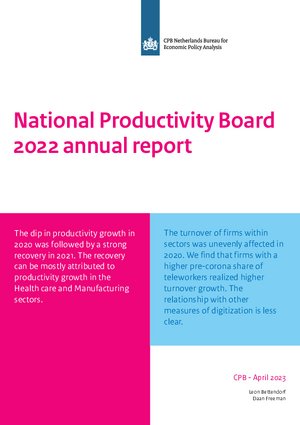National Productivity Board 2022 annual report
We find that digitization may have contributed to the quick recovery of turnover by successful firms in 2020. This first special topic is based on Freeman and Bettendorf (2023). The observation that turnover of firms within sectors is unevenly affected in 2020 raises the question if this is related to measures of their pre-corona digitization. We find the expected, positive relationship between the initial share of teleworking and turnover growth of firms. However, we do not find evidence that firms with good starting positions in ICT and software investments to be more resilient than other companies in 2020.
Downloads
The extensive support package in 2020 prevented relatively more exits of low-productive firms. We summarize as second special topic the CPB study by Davies et al. (2023). Observations clearly show that support measures have reduced the exit rates of low-productive firms more than of high-productive firms. A more refined analysis takes into account the finding that non-viable firms have received aid less often than viable firms. This analysis also finds a negative relationship between the number of exits prevented and productivity. The support package thus reduced productivity growth by at least postponing the exits of unviable firms.
We thank Statistics Netherlands for input on this report.
Authors


